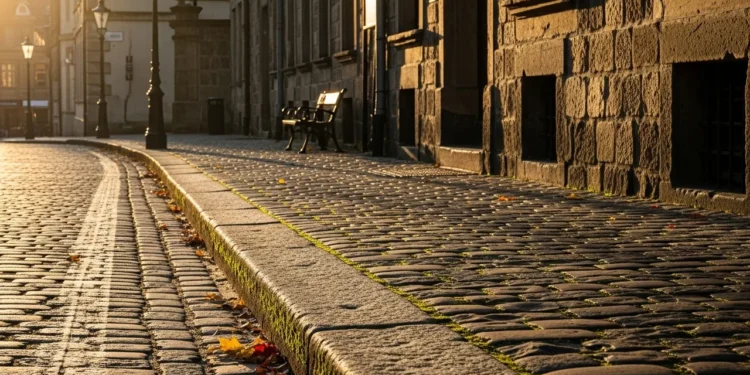Table of Contents
Introduction
The history of the curb is not a story about stones, but a story about power. It is a chronicle of a seemingly mundane feature of our urban landscape that has, for centuries, quietly dictated where we can walk, drive, and even exist. From the moment the first raised edge was laid to separate the filth of the street from the space for pedestrians, the curb became an instrument of control. This simple line of concrete or granite is one of the most powerful and overlooked tools in urban design, an object that defines public space, enforces social norms, and builds physical barriers that often become social ones. This is the flawed history of the curb.
This article dissects that legacy, tracing the curb’s evolution from a simple tool for sanitation and order in ancient Rome and 19th-century Paris into a formidable agent of 20th-century urbanism. We will explore how the rise of the automobile transformed the curb into a fortress wall for the pedestrian, creating a cityscape built for the convenience of the car above all else. This process, driven by traffic engineering and suburban zoning, had profound and often deliberate social consequences, using infrastructure to contain communities and design certain human behaviors out of the public realm entirely, shaping a new chapter in the history of the curb.
Furthermore, we will confront the curb’s inherent legacy of exclusion, examining its role as a daily barrier for people with disabilities and its modern use in hostile architecture to police the unhoused. Finally, we will turn to the innovators and urbanists who are actively rethinking the history of the curb, pioneering designs like shared streets and green infrastructure to heal the divisions it created. By understanding the consequences of the history of the curb, we can begin to see the profound social and political power embedded in the concrete beneath our feet, and question the lines that continue to shape our lives.
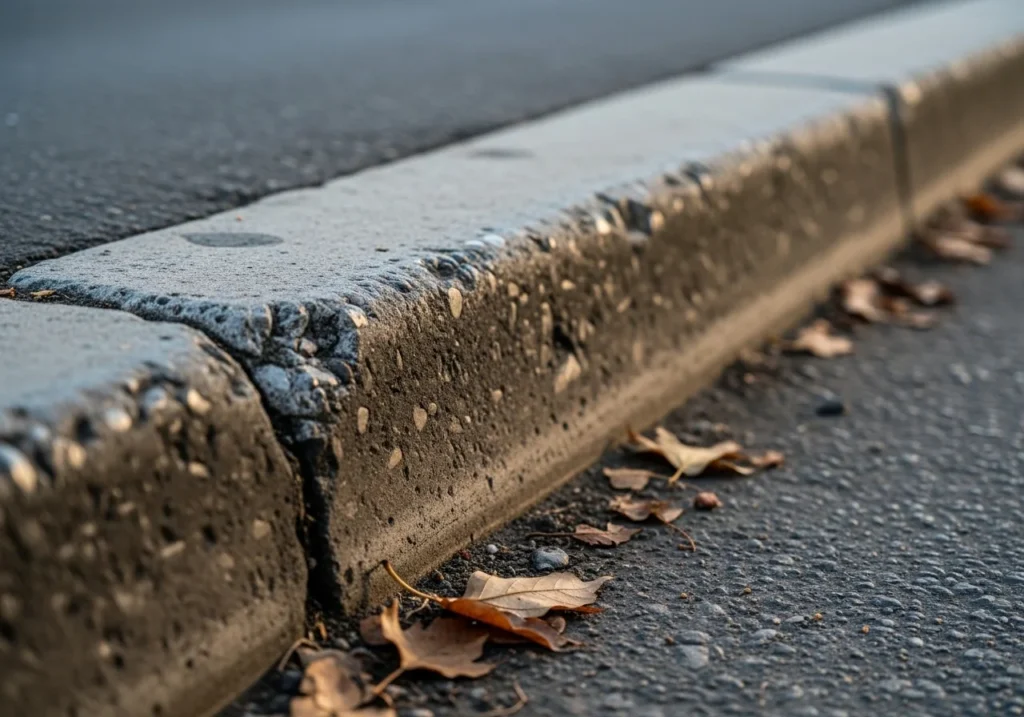
The Birth of the Boundary: Early Innovations in the History of the Curb
Before the formal stone curb lined our streets, the urban thoroughfare was a chaotic, shared space of mud, waste, and commotion. The earliest impulses in the history of the curb arose not from a grand design, but from a basic need for order and safety. In the excavated streets of ancient Pompeii, large stepping stones placed at intervals allowed pedestrians to cross without treading in the filth of the roadway, a clear precursor to the modern pedestrian refuge.
Similarly, Roman cities featured raised sidewalks, rudimentary barriers that separated walkers from the crush of carts and chariots. These early examples show that the desire to delineate space—to create a hierarchy between the pedestrian and the vehicle—is a foundational theme in the long history of the curb.
The concept truly took root during the 19th century, driven by the urgent public health crises of the Industrial Revolution. Cities like London and Paris were overwhelmed with filth, and their unmanaged streets became conduits for diseases like cholera. The raised curb was a revolutionary sanitation tool. It created the gutter, a channel designed to control the flow of wastewater, stormwater, and refuse, directing it away from homes and storefronts and into nascent sewer systems. This innovation was a critical turning point; the history of the curb became inextricably linked with the history of public health, transforming the street edge from a muddy suggestion into a hard, functional line of defense against urban squalor.
Beyond sanitation, the adoption of the curb was also a powerful aesthetic and social statement. As part of grand urban beautification projects, such as Baron Haussmann’s renovation of Paris, uniform granite curbs brought a visual coherence and stately order to the boulevards. This was more than just engineering; it was social engineering. The clean, crisp lines of the curb helped craft a new, respectable public realm, implicitly encouraging orderly conduct and reinforcing a bourgeois vision of the city. This early phase established the curb’s dual identity: a practical tool for infrastructure and a subtle instrument for shaping social space, a theme that would only deepen throughout the history of the curb.
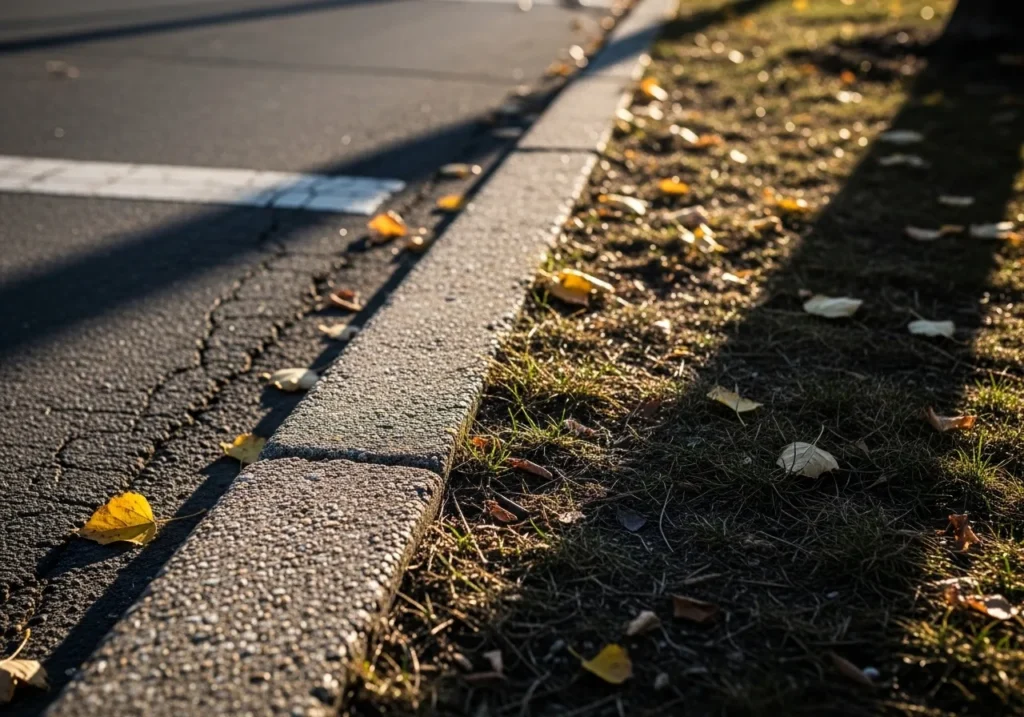
The Curb as a Tool of Order and Control in the 20th Century
The arrival of the automobile in the 20th century radically altered the purpose and physicality of the curb. What was once a modest boundary for pedestrians became a critical tool for traffic engineering, a hard-edged barrier essential for corralling cars. The history of the curb pivoted from managing water to managing speed and steel. Curbs were raised higher and built stronger, creating a rigid channel for vehicular flow that prioritized the car’s dominance over the street. Pedestrians were no longer participants in the streetscape but were relegated to the sidewalk, confined behind this concrete wall. The curb became the primary enforcer of a new urban hierarchy where the car reigned supreme.
This obsession with separation extended beyond the street itself, becoming instrumental in the sprawling development of suburbia. As land-use zoning became standard practice, the curb served as the clean, physical line demarcating distinct zones for living, commerce, and industry. The continuous, unbroken curb of a residential subdivision was a clear signal: this space is for cars and homes, not for spontaneous commercial activity or mixed-use living. This rigid enforcement of separation, a key chapter in the history of the curb, helped create the car-dependent landscapes that defined post-war urbanism, engineering a society where movement between zones required a vehicle.
The social consequences of this control were profound, if not always intentional. The raised curb effectively “designed out” unstructured uses of the street, discouraging street vendors, spontaneous gatherings, and children’s play. It sterilized the public realm, turning vibrant community spaces into mere traffic corridors. In a more deliberate sense, these physical boundaries often reinforced social ones. Infrastructure projects could use curbs and the streets they define to create hard borders around specific neighborhoods, containing populations and discouraging movement across racial or economic lines. In this way, the seemingly neutral history of the curb reveals its role as a quiet but powerful agent of social containment and control.
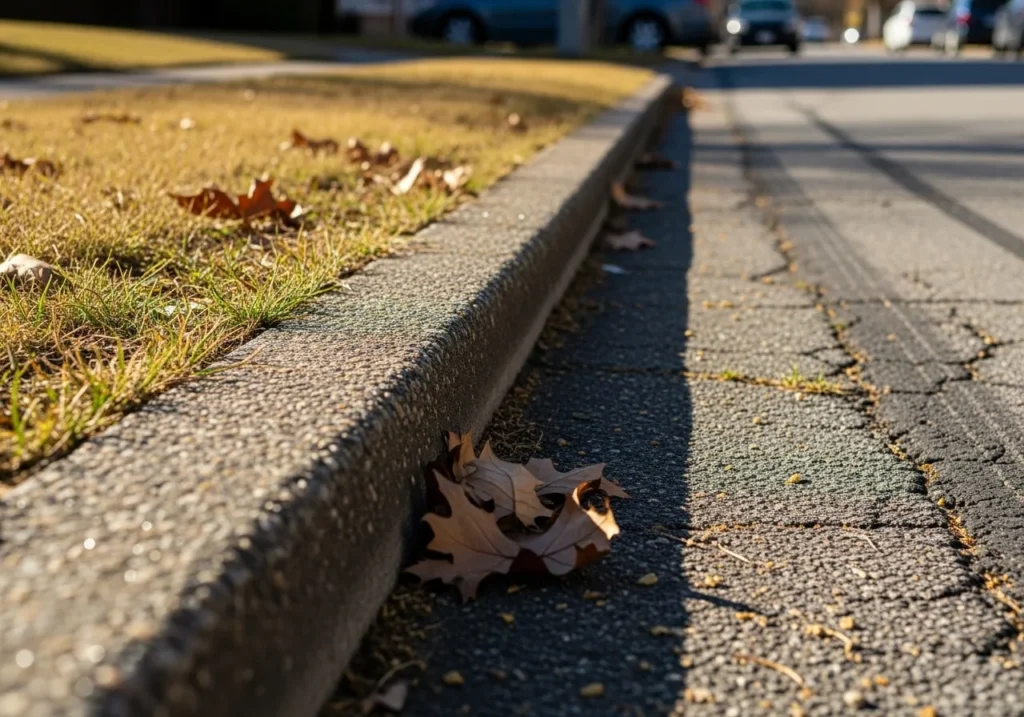
The Flawed History of the Curb: Exclusion and Accessibility
For much of its existence, the history of the curb was written from an able-bodied perspective, creating a cityscape that was profoundly exclusionary. The standard six-inch raised curb, designed to control vehicles and water, became an insurmountable daily obstacle for countless people. For wheelchair users, parents with strollers, and those with mobility impairments, the city was a fragmented landscape of inaccessible islands. Each corner represented a barrier, a point of frustration, and a clear message: this public space was not designed for you. This inherent ableism, embedded in the very concrete of our sidewalks, represents a significant moral failure in the flawed history of the curb.
This systemic exclusion ignited a powerful response from the disability rights movement, which fought to remake the urban environment in the name of civil rights. Activists argued that access to public space was not a convenience but a fundamental right. Their tireless advocacy led to landmark legislation, most notably the Americans with Disabilities Act of 1990, which mandated the installation of curb cuts. This was a revolutionary moment, forcing a widespread rethinking of the history of the curb. The simple, sloped ramp became a potent symbol of universal design, demonstrating that infrastructure could be intentionally shaped to include, rather than exclude, all members of society.
Beyond its accessibility challenges, the curb continues to be used as a tool for more overt forms of social control through “hostile architecture.” Urban planners and private property owners manipulate the street edge to deter behaviors deemed undesirable. Jagged or slanted curbs prevent people from sitting, while raised concrete platforms are designed to make sleeping impossible for the unhoused. Skateboarders are thwarted by metal fins known as “skate stops” fixed to curbs and ledges. These modifications are a deliberate evolution in the history of the curb, transforming it from a passive barrier into an active agent of exclusion that polices who is allowed to comfortably exist in public space.
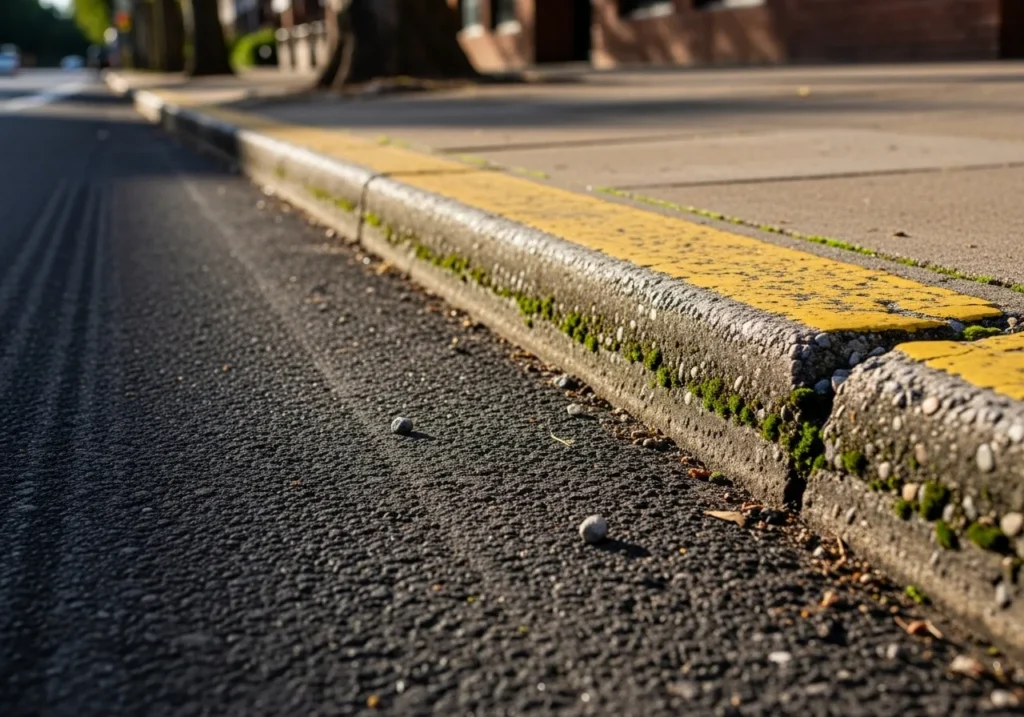
Rethinking the History of the Curb: Modern Designs and Future Visions
In response to the exclusionary and car-centric legacy of the 20th-century street, a new generation of urbanists is actively rethinking the history of the curb by questioning its very existence. Design philosophies such as “shared streets” and the Dutch “woonerf” (or living street) intentionally blur the lines between pedestrian and vehicle. By removing the raised curb and using subtle cues like textured paving and street furniture, these designs create a level, unified surface that forces drivers to slow down and negotiate the space with greater awareness. This approach represents a radical departure, aiming to foster a more equitable and interactive public realm where the car is a guest, not a king.
At the same time, innovators are not just removing the curb but reinventing it. The curb is being reimagined as a dynamic and functional part of the urban ecosystem. “Green curbs” or “curbside bioswales” incorporate planted areas and permeable surfaces directly into the street edge to absorb and filter stormwater, reducing runoff and pollution. In the smart city, the curb is becoming a hub for technology, with embedded sensors that can manage dynamic parking pricing, guide autonomous vehicles, and provide real-time data on traffic and pedestrian flow. This evolution marks a new chapter in the history of the curb, transforming it from a static barrier into a responsive, high-performance piece of infrastructure.
This push for innovation has created a fundamental debate about the curb’s future. On one side are traditional traffic engineers who argue that the raised curb remains an essential safety feature, a last line of defense protecting pedestrians from errant vehicles. On the other are, proponents of universal design and livable communities contend that these barriers inherently create an inaccessible and socially sterile environment. The future of the street edge lies in navigating this tension, finding designs that can achieve the safety goals of traffic control while fulfilling the urgent need for a more inclusive, accessible, and human-centered public space.
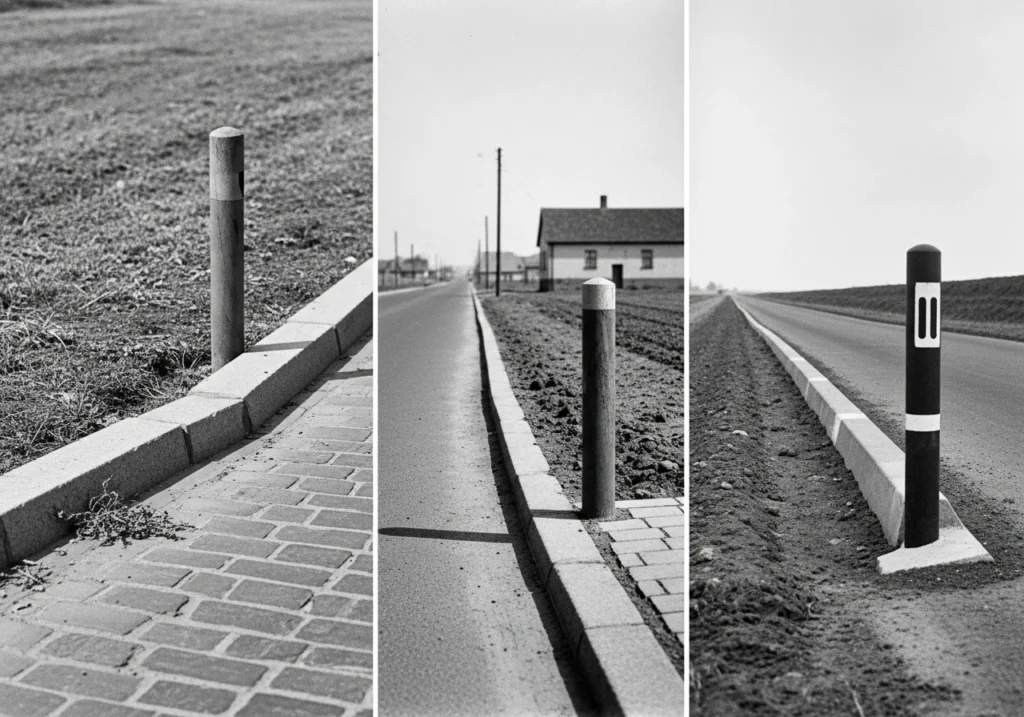
The Consequences of the History of the Curb on Social Geography
The cumulative consequences of the history of the curb are etched into the very map of our cities. For over a century, this simple stone edge has served as the unseen architect of our social geography. By rigidly defining streets for cars, enabling sprawling suburban zoning, and creating hard borders around neighborhoods, the curb has been a quiet accomplice in reinforcing segregation. It has limited the potential for spontaneous commercial and social mixing between adjacent communities, contributing to the economic disparities that often map so cleanly onto urban infrastructure. The history of the curb is, in this sense, a history of lines that do more than divide streets—they divide people.
This physical division has a profound psychological impact. Growing up in a world lined with curbs trains us to perceive public space as a series of prescribed channels and designated zones, rather than a fluid, shared realm. The hard edge subconsciously signals danger and restriction, fostering a mindset of prescribed movement where we walk only on the sidewalk and drive only on the road. This mentality stifles the organic, unpredictable interactions that build vibrant community life. We learn to see the street as a space to move through, not a place to be. The consequences of the history of the curb are not just social and economic; they are cognitive.
Recognizing this, cities are beginning to actively dismantle this legacy. In places like Poynton in the UK, radical “shared space” schemes have removed curbs and traffic signals, forcing drivers and pedestrians to negotiate with each other and fostering a renewed sense of community ownership over the street. These projects have seen accident rates plummet and local economies thrive as revitalized public spaces draw more foot traffic. By intentionally erasing the lines, these cities are demonstrating that the consequences of the history of the curb are not permanent. Redesigning the edge is a powerful first step in redesigning a more connected and equitable public life.
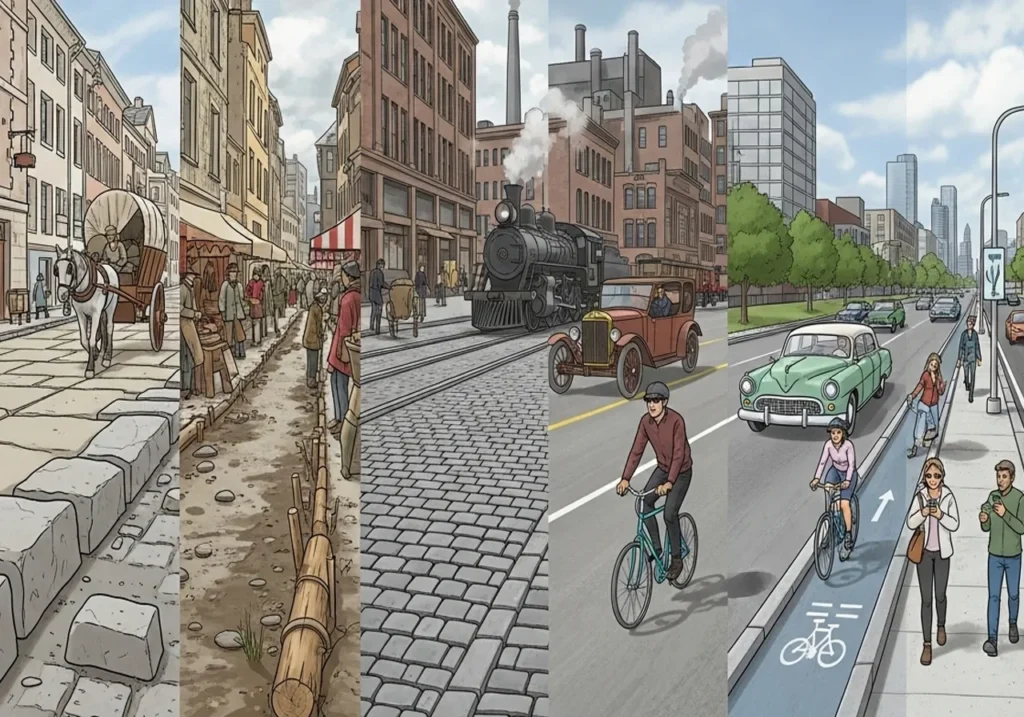
Conclusion
Throughout this exploration, we have seen that the history of the curb is far more than a simple account of street-side infrastructure. It began as a necessary innovation, a raised line to bring order, sanitation, and aesthetic dignity to the chaotic streets of burgeoning cities. Yet, with the dawn of the automobile age, its function was radically repurposed. The curb became the primary enforcer of a new, car-centric world, a rigid barrier that carved up public space to prioritize vehicular flow, enabled the zoned separation of suburbia, and began a long legacy of turning shared community spaces into mere traffic corridors.
The consequences of history of the curb reveals a deep and troubling story of exclusion. For decades, this standard feature of our built environment created a world of barriers for people with disabilities, a clear physical manifestation of an ableist design philosophy. This flawed history of the curb continues today in the form of hostile architecture, where the street edge is weaponized to control and displace the most vulnerable among us. The curb, we have learned, is not a neutral divider; it is an active agent in shaping social geography, subtly enforcing who belongs in public space and how they are permitted to exist within it.
Therefore, the main message is clear: the lines we draw with concrete and stone are never just lines. They are powerful statements about our values and priorities. As we move forward, rethinking the history of the curb is not just an academic exercise but a critical task for building more equitable and connected cities. The challenge for urbanists, planners, and citizens is to see the curb for what it is—a tool with a profound capacity to both divide and unite. By consciously choosing designs that lower barriers, foster interaction, and prioritize people, we can begin to reshape our public spaces into reflections of the inclusive communities we hope to create.
